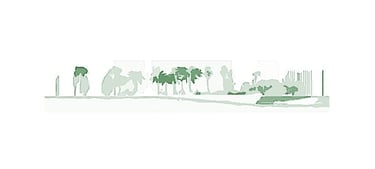🌿 1. Philosophical basis: landscape as natural capital
The starting point is a contemporary reinterpretation of landscape.
It is no longer understood as ‘decoration’ or ‘aesthetic environment’, but as living infrastructure and an essential economic asset.
Natural capital encompasses all the elements that sustain life and the economy: fertile soils, clean water, biodiversity, stable climate, cultural landscapes, and even the ecosystem services that generate well-being and territorial brand value.
→ Landscape, therefore, is natural capital because it produces long-term ecological, social, and economic returns.
Thus, Strategic Landscape Development (SLD) is not a visual luxury, but an investment in territorial resilience and economic competitiveness.
💰 2. Economic rationale: the profitability of landscape
The SLD's Economic Strategy is based on turning landscape into a driver of added value and structural savings.
A well-designed landscape generates tangible and measurable value on several fronts:
Real estate and land value
An environment with high-quality landscaping increases the value of urban, tourist or residential assets by between 15 and 30%, according to European studies.
Aesthetics, vegetation, climatic comfort and local identity are decisive factors in investment decisions.
Tax and energy savings
A well-planned strategic landscape reduces water, energy and urban maintenance costs.
The DPE acts as green infrastructure, replacing more expensive and less sustainable grey solutions.
Circular and local economy
Landscape generates local economies: local nurseries, maintenance, tourism, ecological restoration and green jobs.
The DPE creates a regenerative, non-extractive economic ecosystem.
Brand value and capital attraction
In the global context, investors are looking for projects with ESG (Environmental, Social, Governance) certification.
A territory with a well-managed strategic landscape increases its ability to attract investment and talent because it projects stability, beauty and long-term vision.
🧭 3. Operational basis: the economic strategy of SLD
This is where the strategic landscape architecture approach comes in.
Strategic Landscape Development translates natural capital into financial and reputational capital through a series of coordinated actions:
Natural capital diagnosis: identifying existing landscape assets and their economic potential.
Integrated green infrastructure design: converting these assets into functional structures within the territory (water, shade, mobility, identity).
Smart management and maintenance: management models that guarantee long-term profitability and efficiency.
Landscape communication and branding: translating landscape value into the language of economics and investment.
Landscape return assessment: metrics that quantify environmental, social and economic benefits (resilience, tourism, urban quality, energy savings, etc.).
🌍 Conclusion:
→ The DPE transforms the landscape into active natural capital, and natural capital into economic strategy.
→ It is not an aesthetic issue, but a structural one: the landscape becomes the green balance of the territory.
The territory that embraces this logic not only protects its environment: it makes it profitable, competitive and culturally relevant.
STRATEGIC LANDSCAPE DEVELOPMENT
Landscape is Natural Capital: The Economic Strategy of the SLD


LANDSCAPE ARCHITECTURE
What is landscape architecture?
Landscape architecture is a comprehensive discipline that encompasses the analysis, planning, design, management, preservation and rehabilitation of land, as well as the management of the natural and built environment, the environment, science and art.
What services do you offer?
How do you start a project?
Who are the professionals?
With a team of experts in landscape design and execution, with extensive experience in the sector, who analyse and evaluate all the physical, natural and urban elements needed to start an idea, a design, a project, a solution and a result.
Professionals with a comprehensive vision of the territory, physical and urban planning, and the environment. With training in graphic design, technical, humanistic, ecological, and landscape design.
Landscape architects design spaces, plan the location and layout of buildings, develop the environment in urban, suburban and rural areas, organise the territory, arrange green spaces, parks and large forests, playgrounds and sports areas, zoos, recreation areas, leisure and water attractions, residential complexes and hotels, university centres, offices and business centres, shopping centres, gardens, golf courses, restoration of gardens and historic sites, access roads, paths, exhibitions, decoration and ornaments of the place, fountains and the arrangement of vegetation, trees, shrubs, plants and flowers, etc.
Advancing in practice, advocacy, education, and communication for better use of the aesthetic, social, functional, and ecological capacity of landscape planning, with an ethical commitment to conserve and improve the land for the progress and quality of life of all people and to consolidate the relationship between humans and their environment, their balanced integration into nature, with architecture, science, the environment, art and appreciation of place.
What are your objectives?
What do they contribute to society?
A social and environmental vision that facilitates the interpretation and sustainable management of resources, water, air, soil, landscape, energy, etc., and awareness of human needs, enabling the necessary encounter between man and his environment, improving living standards and promoting cultural exchange and human relations.
What is your commitment?
Sharing a deep appreciation for the environment, a commitment to the highest standards of landscape planning and design, management, conservation and development, solving environmental impact issues in the proposed development, determining the best use for each plot of land and responsible land management, guiding actions in terms of car and pedestrian traffic, and adding beauty, with the reward of work that directly improves people's quality of life.
What is your relationship with developers, builders, estate agents, architects and administrators?
Through the practice of quality and sustainable design, creative, clear solutions are offered that respect the territory, its planning and the environment, in other words, we must connect with an appreciation for the place, build relationships with future clients and satisfy their needs with the environment, providing balance through innovation, combating climate change, minimising the effect of heat islands in cities, restoring habitats, improving air quality, managing water resources in a balanced way, and taking care of the whole by paying attention to both the built space and common areas.
Landscape architects, real estate professionals, developers and builders, as well as government officials, will have to work together to develop projects that enable spaces to be used as assets for sustainable development, making the benefits of contact with nature available to people.




